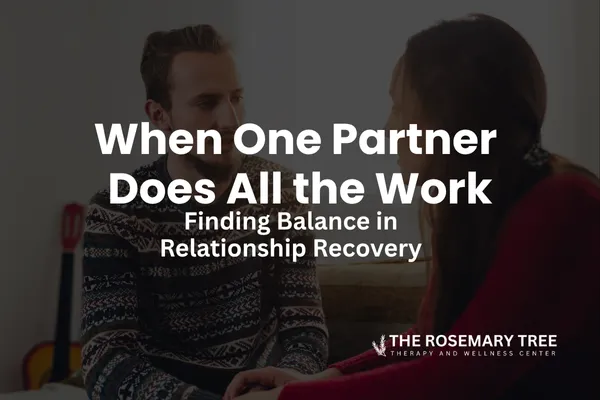
When One Partner Does All the Work: Finding Balance in Relationship Recovery
When Healing Feels One-Sided
In the months after betrayal or major conflict, it’s common for one partner to take the lead in seeking healing, reading the books, scheduling therapy, or pushing for communication, while the other withdraws or avoids.
Over time, this imbalance begins to strain the relationship again. The partner doing most of the emotional work grows resentful and exhausted. The partner doing less often feels overwhelmed, guilty, or defensive. Both end up disconnected and discouraged.
As we discussed in Taking Ownership Without Shame, accountability is essential to rebuilding trust. But accountability only works when it’s shared. Healing can’t rest on one person’s shoulders.
Why This Imbalance Happens
Uneven effort doesn’t always come from unwillingness. Often, it’s driven by deeper fears and emotional defenses:
Avoidance: One partner feels ashamed or afraid of making things worse, so they stay quiet.
Over-functioning: The other takes control to avoid feeling powerless or abandoned again.
Burnout: When communication feels hard, both default to familiar patterns of survival — one pursuing, one withdrawing.
These patterns are normal trauma responses, not signs of hopelessness. But left unchecked, they can recreate the same emotional distance that caused the hurt in the first place.
The Emotional Cost of Doing It Alone
When one person becomes the “emotional caretaker” of the relationship, resentment and exhaustion follow quickly. You may start to feel like you are dragging the healing process forward while your partner just watches.
The truth is, you can’t rebuild a relationship alone. You can model growth and invite engagement, but sustainable healing requires both partners to participate.
Without balance, the relationship dynamic begins to mirror the pain of the betrayal, one partner overextending while the other withdraws. This is where guided therapy becomes essential.
The Goal: Shared Responsibility, Not Equal Perfection
Balance does not mean both people contribute in the exact same way. It means each partner takes ownership in a way that matches their role, their healing stage, and their capacity.
For example:
The partner who caused the harm leads in rebuilding safety through consistency and honesty.
The betrayed partner leads in expressing needs and boundaries clearly without self-blame.
Both commit to curiosity, communication, and growth at a sustainable pace.
Balance looks like two people showing up differently, but together.
Tying This Back to Attachment and Intimacy
As explored in Rebuilding Desire — When Love and Fear Coexist, intimacy returns when safety replaces fear. But safety is only sustainable when effort is mutual. When one person is always reaching and the other is always retreating, both nervous systems remain on alert.
In attachment terms, the “pursuer-withdrawer” cycle continues until effort feels shared again. When each partner begins to take responsibility for their emotional responses, the relationship stabilizes and intimacy naturally deepens.
How to Restore Balance in the Healing Process
Identify the Pattern Together
Name what’s happening without blame. Saying “I feel like I’m carrying more of the emotional weight” opens the door for awareness and teamwork.Clarify What Effort Looks Like
Discuss what “showing up” means for both of you, attending sessions, checking in daily, reading materials, or practicing new communication tools.Set Gentle, Realistic Expectations
Healing is not a race. Agree on small, achievable steps so neither partner feels overwhelmed or left behind.Acknowledge Each Other’s Effort
Recognition builds momentum. Gratitude softens defensiveness and encourages continued effort.Seek Guidance When You Feel Stuck
When imbalance persists, a structured setting like an intensive helps both partners reset expectations and rebuild motivation together.
How Accelerated Outcomes Therapy Helps Restore Balance
Our Accelerated Outcomes Therapy Intensives were created for couples who feel stuck in this exact pattern.
In these sessions, couples have the time and professional guidance to:
Identify emotional labor imbalances with compassion
Rebalance responsibility through clear, structured dialogue
Practice communication that prevents resentment
Build an action plan for sustainable healing at home
Experience teamwork again instead of tension
With several focused hours of support, couples can begin shifting from frustration to forward movement, together.
When You Feel Alone in the Effort
If you’re the one carrying most of the emotional weight right now, know that your desire to heal is a strength, not a weakness. But you deserve to feel supported too.
And if you’re the one struggling to engage, it’s okay. Avoidance is a protective instinct, not a lack of love. The goal isn’t to blame, but to gently step back into participation at your own pace.
Healing works best when both partners bring their willingness to grow, not perfection, just effort.
Final Thoughts
Lasting recovery requires shared effort, honest communication, and compassion for each other’s pace. Balance doesn’t mean keeping score. It means learning how to move together again, one step at a time.
If you and your partner are ready to rediscover that balance, we would be honored to help. You can reach out to us here, and our team will connect with you to talk about what this process could look like. There is no pressure, only care and a space to rebuild together with clarity and hope.
